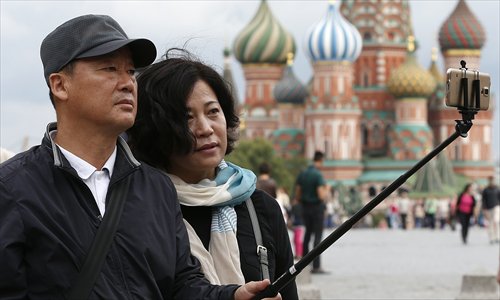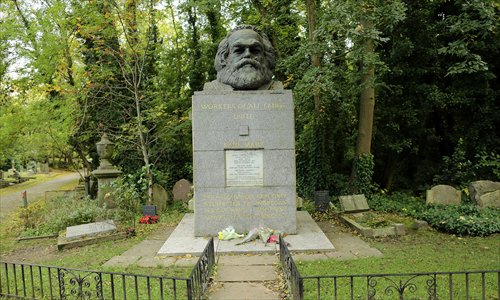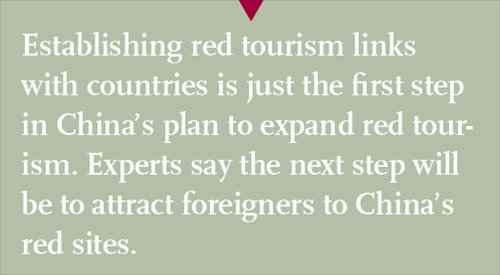Chinese tourists walk in footsteps of Marx and Lenin in UK, Russia
Red tourism is going global as more and more Chinese tourists are drawn to visiting revolutionary attractions in countries like Russia, which share a communist past with China, or countries where famous revolutionaries have lived. As these countries tap into China's red tourism market, China is also hoping to attract more international tourists to its red sites so as too better tell China's story to the world.

Chinese tourists take selfies on Red Square in Moscow, Russia. Photo: IC
Highgate Cemetery in North London recently welcomed 20 Chinese visitors.
They stood in a row facing a grave, bowed three times, and then paid silent tribute to their intellectual hero - Karl Marx.
This was the highlight of a packaged tour entitled "Walking in Marx's footsteps in Britain," organized by a Beijing-based company that specializes in red tourism abroad. For the tourists visiting Marx's grave, that day was especially meaningful because it was the 133rd anniversary of the German philosopher's death.
After the silent tribute, two leftist scholars that were part of the group, Sima Nan and Li Yan, made speeches summarizing the life of Marx and his influence on China. They ended the ceremony by singing The Internationale, a socialist anthem.
The nine-day tour also stopped at Marx's former residence on Dean Street where he lived from 1851 to 1856, the British Museum where he did his research and writing, the Marx Memorial Library and the apartment at 41 Maitland Park Road, Hampstead where Marx spent his last years.
"Britain is a capitalist country with a long history and rich culture… For us tourists who believe in Marxism-Leninism and Mao Zedong Thought, however, we visit here mainly because it's the place where Capital was written, and because Marx spent his last years here and we want to hold a memorial ceremony for him," He Shouwu, who joined the trip, wrote online.
Xinghuo Travel, which organized the tour, is one of a growing number of companies that hope to tap into China's outbound red tourism market, which is expected to expand with central government approval in recent years. In the past years, the company has organized trips to Canada to remember Canadian physician and communist Norman Bethune, who is known as a hero in China for his work as a medic during the War against Japanese Aggression (1937-45), to Cuba to see its socialist society, and to North Korea to remember the Chinese People's Volunteer Army who fought and died in the Korean War (1950-53), among other destinations.

Karl Marx's grave in Highgate Cemetery, North London. Photo: CFP
Red resurgence
Red tourism is not a new thing in China. The Chinese government and Party has been promoting it since 2004, the year in which they coined the term, and over the past decade, China has invested over 9 billion yuan ($1.39 billion) in the construction of red tourism sites and tours, according to the National Red Tourism Coordination Executive Team. Every year, millions of visitors flock to China's red sites to pay tribute to former communist leaders and learn about the Communist Party of China's (CPC) revolutionary past.
Although visitors have been growing at over 16 percent a year on average, red tourism hasn't always been in favor with the Chinese government. In 2012 and 2013, after former CPC politburo member and a devout advocate of "red culture" Bo Xilai was convicted on corruption charges, red tourism went through a "sensitive period," a tourism industry insider who declined to be named told the Global Times. He said some companies even changed the name of their red tours to "healthy tours" to be less conspicuous.
In 2014, the State Council, China's cabinet, showed its approval of red tourism in a document on reforming and developing outbound tourism, in which it advocated the promotion of red tourism and education in revolutionary traditions so as to boost people's "socialist core values," a set of virtues that include harmony, patriotism and prosperity.
President Xi Jinping has also mentioned red tourism multiple times. When he visited Northwest China's Shaanxi Province, home to the CPC's wartime base, in February last year, he said that red tourism must be developed with a precise orientation, centering around red education and the inheritance of red genes, so that party cadres and ordinary people can be immersed in "red spirits" when they visit the sites.
"The State Council and President Xi's mentions of red tourism boosted our confidence greatly," Diao Weiming, manager of Xinghuo Travel, told the Global Times.

International pilgrimage
As China's red tourism goes global, Russia, which shares a similar communist past with China, is expected to be the biggest winner. Last June, travel authorities from China and Russia signed a cooperative agreement in Shaoshan, Central China's Hunan Province, Mao Zedong's birthplace, to develop red tourism routes in both countries.
Apart from traditional tourist destinations like Moscow and St. Petersburg, Russia's red route also includes Ulyanovsk, Lenin's birthplace, and Kazan, the city where he studied.
The cooperation program seems to have paid off for the Russians. Data from the Moscow tourism department shows that over 1 million tourists from China visited Russia in 2015, a 51 percent increase on the year before. They spent nearly $1 billion.
Ulyanovsk is expected to become Russia's version of Shaoshan, heart of China's red tourism. Government officials from Ulyanovsk said the city will build a China park to cater to Chinese tourists, which will be equipped with hotels, a Chinese supermarket, traditional Chinese medicine medical center, commercial complexes and a Russia-China research institute. The park will be the next step in Russia's effort to attract Chinese tourists and boost red tourism, Sputnik News reported.
Moscow is also planning to rebuild the venue where the sixth national congress of the CPC was held and turn it into a memorial museum. In 1928, CPC moved the venue of its congress to Moscow.
The Ivanovo International Children's Home, about 300 kilometers east of Moscow which used to be a home for the children of revolutionaries around the world including Mao Anying, son of Mao Zedong, and Zhu Min, daughter of Chinese general Zhu De in the 1930s and 40s, is also considering opening its doors to Chinese tourists, the Xinhua News Agency reported.
Inbound
Establishing red tourism links with countries is just the first step in China's plan to expand red tourism. Experts say the next step will be to attract foreigners to China's red sites.
"China is at the point of development that it wants the world to listen to our voice. We need to tell China's story well to an international audience and show our confidence in it," Li Zhong, deputy head of the College of Tourism and Service Management at Nankai University, told the Global Times.
Li was recently commissioned by the China National Tourism Administration to conduct research into the globalization of red tourism, and he reveals that globalizing red tourism will be the next target for China's official tourism body. That includes designing red tourism products for international tourists and bringing China's red tourism sites up to international standards, he said.
But the strong ideological overtones of China's red tourism sites have incurred doubts over whether they can successfully attract international travelers.
The popularity of traditional red tourism spots are still limited among international tourists. According to official statistics, 16.82 million tourists visited Shaoshan, the heart of red tourism in China, in 2015, a 28 percent increase over 2014. Among them, only 160,000 were foreign tourists - accounting for less than one percent.
On tripadvisor.com, a popular travel website that provides reviews for tourists, Mao Zedong's former residence in Shaoshan only has 91 user reviews, most of which are in Chinese, as opposed to thousands of reviews in English and Chinese under natural tourist attractions like Jiuzhaigou, a nature reserve in Southwest China's Sichuan Province.
"There will definitely be curious foreigners who are interested in these attractions, but considering the differences between China and the West in ideology and social systems, it's unlikely that red tourism will attract a large international following," Liu Simin, deputy director at the China Society for Future Tourism Studies, told the Global Times.
Li Zhong also admits that there is a long way to go. "Red tourism, after all, is a form of tourism. China's red tourism sites are not the reason the majority of international tourists visit China."
Contrary to what some had expected, however, ideology doesn't seem to be the biggest problem, according to some tourists. A tourist from Singapore, who visited Mao's former residence this January, commented that the site is "too commercial." "We were led to a museum and were asked to buy souvenirs and small statues. Very commercialized and … I think it should not be glorified in this way," the tourist's review said.
Newspaper headline: The West is red